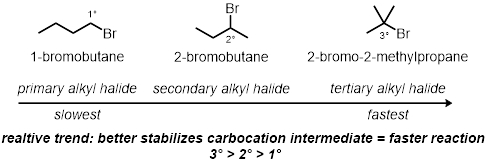求核置換反応
概要
ソース: Vy 雅洞とダニエル ・ キム、化学、カリフォルニア大学アーバイン校、カリフォルニア州部
求核置換反応は、有機化学における最も基本的なトピックの一つです。求核置換反応は、求核剤 (電子が豊富なルイス ・ ベース) が炭素原子から去るグループを置き換える 1 つです。
SN1 (S = 置換、N = 1 Nucleophilic 最初順序の動力学を =)
SN2 (S = N 置換 Nucleophilic、2 = = 二次速度)
このビデオは SN1 と SN2 の間の微妙な違いを視覚化するのに役立ちます反応と求核置換反応の各タイプを迅速化するため要因。最初のセクションがよりよく理解し、求核置換反応について説明するのに役立ちます反応に焦点を当てます。2 番目のセクションは、置換反応の実世界の例について説明します。
手順
パート 1: 勉強 SN1 反応
アルキル ハロゲン化物の構造:
- それぞれの 3 つの試験管に無水エタノールで硝酸銀の 0.1 M の溶液 2 mL を測定します。
- 最初の試験管に 1 bromobutane の 2 滴を追加します。第 2 の試験管に 2 bromobutane の 2 滴を追加します。
- 最終的に 2-ブロモ-2-methylpropane の 2 滴を追加第 3 テスト チューブ。
- ストッパー、各試験管を振る。
- 曇りまたは沈殿物の最初の兆候が表示されます時間を注意してください。
グループ効果を残してください。
- 各 2 つの試験管に 2 mL の無水エタノールに硝酸銀の 0.1 M 溶液を測定します。
- 最初の試験管に 2 滴を第 2 の試験管に 2-クロロ-2-methylpropane、2-ブロモ-2-methylpropane
結果
申請書と概要
タグ
スキップ先...
このコレクションのビデオ:

Now Playing
求核置換反応
Organic Chemistry II
99.7K 閲覧数

クリーニングのガラス製品
Organic Chemistry II
123.9K 閲覧数

還元剤
Organic Chemistry II
43.2K 閲覧数

グリニャール反応
Organic Chemistry II
149.3K 閲覧数

n- ブチル リチウムの滴定
Organic Chemistry II
48.1K 閲覧数

ディーン ・ スターク ・ トラップ
Organic Chemistry II
100.7K 閲覧数

アルケンのオゾン分解
Organic Chemistry II
67.2K 閲覧数

有機触媒反応
Organic Chemistry II
17.0K 閲覧数

パラジウム触媒クロス カップリング
Organic Chemistry II
34.7K 閲覧数

固相合成
Organic Chemistry II
41.3K 閲覧数

水素化
Organic Chemistry II
49.7K 閲覧数

重合
Organic Chemistry II
94.9K 閲覧数

融点
Organic Chemistry II
150.1K 閲覧数

赤外分光法
Organic Chemistry II
216.3K 閲覧数

旋光計
Organic Chemistry II
100.3K 閲覧数
Copyright © 2023 MyJoVE Corporation. All rights reserved
